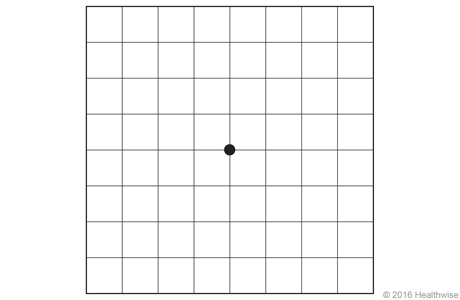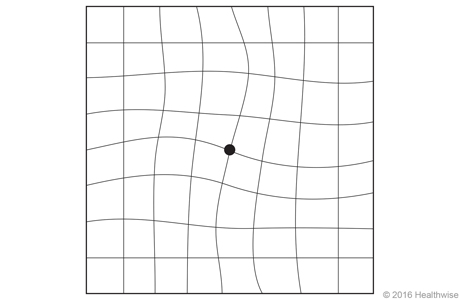Healthwise
Our Health Library information does not replace the advice of a doctor. Please be advised that this information is made available to assist our patients to learn more about their health. Our providers may not see and/or treat all topics found herein.
Age-Related Macular Degeneration
Condition Basics
What is age-related macular degeneration (AMD)?
Age-related macular degeneration (AMD) is a disease that causes blurring of your central vision. The blurring happens because of damage to the macula, a small area at the back of the eye. The macula helps you see the fine detail in things that your eyes are focusing on.
Macular degeneration makes it harder to do things that require sharp central vision, like reading, driving, and recognizing faces. It does not affect side vision, so it does not lead to complete blindness.
There are two types of macular degeneration—wet and dry. The dry form is by far the most common type. The wet form is much less common, but it happens more quickly and is more severe.
You may have either type in just one eye, but over time you may get it in the other eye too.
What causes it?
AMD is the result of damage to the light-detecting nerve cells in the part of the eye called the macula. The cause of the damage to the nerve cells is unknown. A person's genes and family history may play a role.
What are the symptoms?
The main symptom of AMD is dim or fuzzy central vision. Objects may look warped or smaller than they are. You may have a blank spot in your central vision. Symptoms can depend on the type of AMD. Dry AMD happens slowly. Wet AMD happens suddenly and is more severe.
How is it diagnosed?
A doctor can usually detect AMD by doing a regular eye exam. The doctor will ask about your symptoms, past eye problems, and other health conditions. You may have some vision tests, including an ophthalmoscopy, visual acuity test, or Amsler grid test. These tests let your doctor check for signs of the disease.
How is macular degeneration treated?
There is no cure for AMD. But certain treatments may delay vision loss.
Your doctor can refer you to professionals who help people adjust to living with low vision.
For dry AMD, follow your doctor's advice for having regular exams and watching the condition at home, because dry AMD can sometimes develop into wet AMD. Certain vitamin and mineral supplements may help slow vision loss. Check with your doctor before taking any supplements. Some can have harmful side effects.
Treatment for wet AMD can sometimes delay further damage to your central vision. But in most cases, wet AMD starts again. The main treatment for wet AMD is a medicine that is injected into your eye. Sometimes other treatments may be recommended.
Because wet AMD often causes rapid and severe loss of central vision, it is important not to delay treatment if your doctor recommends it.
How can you cope with the changes in your vision?
To cope with AMD, try magnifying glasses, brighter lighting, and large-print books. Your doctor may refer you to an occupational therapist or rehabilitation specialist for help. Local agencies may offer services. You may have a range of emotions about AMD. If you feel very sad or hopeless, tell your doctor.
Health Tools
Health Tools help you make wise health decisions or take action to improve your health.
What Increases Your Risk
The main things that put you at risk (risk factors) for age-related macular degeneration (AMD) include:
- Age greater than 55.
-
Older age is the biggest risk factor for getting AMD.
- A family history of the disease.
-
You are much more likely to get AMD if a close relative has it.
- Race.
-
If your ancestors were from northern Europe, you might be at higher risk.
- Smoking.
-
People who smoke are more likely to develop AMD than nonsmokers.
Other risk factors for developing AMD may include:footnote 1
- Deposits at the back of the eye, called drusen. Eyes with large, soft drusen deposits are at a greater risk for developing abnormal blood vessels and wet AMD.
- A diet high in saturated fat and cholesterol.
- Not getting enough carotenoids, antioxidant vitamins, and zinc in your diet.
Prevention
You can't prevent age-related macular degeneration (AMD). But there are some steps you can take that may lower your risk of getting it.
- Have regular eye exams.
Eye exams may help you find out if you are at risk for AMD or, if you have AMD, may detect it early. Early detection can sometimes delay loss of vision.
- Don't smoke.
People who smoke are more likely to develop AMD than those who don't smoke. Even after you stop smoking, this increased risk may persist for many years.
- Get regular exercise, and stay at a healthy weight.
These choices may lower your risk of getting AMD.footnote 2
People who have an increased risk for AMD should use the Amsler grid. Your doctor can give you one to use at home.
Symptoms
AMD can cause these symptoms:
- Central vision becomes dim, fuzzy, or less sharp. This is the main symptom of macular degeneration.
- Straight lines begin to appear wavy or curved. This is usually the first symptom of wet AMD.
- Objects appear warped, distorted, or smaller than they really are.
- A new blank or blind spot develops in your central field of vision.
- Reading requires more light than it did in the past.
- You find it harder to see people's faces clearly.
- You have a loss of central vision that doesn't go away or becomes worse over time.
Dry AMD happens slowly. Vision changes may be so gradual that you don't notice them. You may have it for several years before it affects your ability to read, drive, and do everyday activities.
Wet AMD happens suddenly. Symptoms tend to appear suddenly and get worse fast.
What Happens
With dry age-related macular degeneration (dry AMD), the cells and blood vessels beneath the macula begin to thin and break down as they age.
You may have the disease for several years before it affects how you are able to read, drive, and do everyday activities. If you have AMD in only one eye, you may not notice minor vision changes, because your unaffected eye automatically makes up for vision problems in your other eye.
A small percentage of people who have dry AMD eventually develop wet AMD.
Wet AMD begins with the growth of abnormal blood vessels under the macula. These blood vessels break easily. They leak blood and fluid and cause scar tissue, all of which push against the macula.
Dry AMD happens slowly, but wet AMD happens suddenly. And wet AMD tends to cause more severe vision changes and vision loss.
When to Call
Call your doctor now if:
- You have a sudden, rapid loss of vision.
- You suddenly notice a new blank or dark spot in the center of your vision that doesn't go away.
- Straight lines appear wavy or curved, or objects begin to change size or shape or appear distorted.
Your doctor will refer you to an eye doctor (ophthalmologist) if needed.
Call your doctor to discuss whether you need an eye exam if:
- You see either of the following on an Amsler grid:
- Lines that change or appear wavy and curved
- A blank spot that you haven't noticed before in the grid
- You need more light to read than you used to.
- Colors seem faded or less vivid than they used to.
- Your vision seems to be getting more blurry.
Watchful waiting
Watchful waiting means to take a wait-and-see approach.
Watchful waiting is not the right choice if you have rapid vision loss or sudden changes in your vision. If you have any rapid vision changes, go to your doctor as soon as you can. Getting treatment right away may be able to slow vision loss caused by wet AMD. Delaying treatment for wet AMD could mean further loss of central vision.
If you have dry age-related macular degeneration (dry AMD), watchful waiting is okay. You may never develop vision loss to the point that it disrupts your regular lifestyle.
Check your symptoms
Exams and Tests
A doctor can usually detect AMD by doing a regular eye exam. The doctor will ask about your symptoms, past eye problems, and other health conditions.
You may have some vision tests.
- A visual acuity test checks your central vision. Central vision gets worse over time in a person who has AMD, and a visual acuity test can measure whether your vision has become worse since your last exam.
- Ophthalmoscopy lets your doctor look inside your eye to check for signs of AMD.
- An Amsler grid test can detect wet AMD. If you have wet AMD, lines on a grid appear wavy or curved instead of straight, or you may see a blank spot or hole on part of the grid.
The American Academy of Ophthalmology recommends that all people ages 40 to 54 have a comprehensive eye exam every 2 to 4 years. This helps to detect AMD early.
Testing your vision with an Amsler grid


An Amsler grid is a chart with horizontal and vertical lines that form boxes. It has a dot in the center. An Amsler grid is one of the easiest ways to screen for age-related macular degeneration (AMD). Your doctor may give you an Amsler grid to use at home.
If you usually wear reading glasses, put them on, and place the grid a normal reading distance from your face.
- Cover your right eye.
- With your left eye, look at the grid. Focus on the dot in the center, but pay attention to the lines around it.
- Repeat with the left eye covered and the right eye focused on the dot.
If you have macular degeneration, the lines may appear wavy or curved, or you may see a blank or dark area in the middle of the grid.
The grid below shows one example of how the straight lines in the grid above might look wavy to someone with macular degeneration.
Learn more
Treatment Overview
There is no cure for AMD. But certain treatments may delay vision loss.
Your doctor can refer you to professionals who specialize in helping people adjust to living with low vision.
Dry AMD
Follow your doctor's advice for having regular exams and for watching the condition at home (such as using an Amsler grid). Sometimes dry AMD can develop into wet AMD.
Certain vitamin and mineral supplements may help slow vision loss. Studies show that antioxidant vitamin and mineral supplements can help delay the onset of advanced AMD. Or they can help prevent further vision loss in people who have moderate AMD.footnote 1 Check with your doctor before taking any supplements. Some can have harmful side effects, especially if you take high doses.
Wet AMD
Treatment for wet AMD can sometimes slow down or delay more damage to your central vision. But in most cases, growth of fragile new blood vessels in wet AMD starts again. And even repeated treatment often doesn't work well over the long term to prevent some loss of central vision.
The main treatment for wet AMD is a medicine that is injected into your eye. This is called anti-VEGF medicine. Sometimes other treatments may be recommended, such as photodynamic therapy. This therapy uses a light-sensitive medicine to block abnormal blood vessels beneath the macula.
Your doctor may also recommend laser surgery, which uses an intense beam of light to burn small areas of the retina and the abnormal blood vessels beneath the macula.
Because wet AMD often causes rapid and severe loss of central vision, it is important not to delay treatment if your doctor recommends it.
Learn more
Self-Care
There's no treatment that can cure age-related macular degeneration (AMD). But there are things you can do at home to care for your eyes.
People with AMD should check the vision in both eyes using an Amsler grid every day or as often as the doctor recommends. If any of the lines on the grid change or begin to appear wavy and curved, or if you notice that your vision is getting worse, call your doctor.
Reduced vision or vision loss from AMD can affect your life in many ways. How much it will affect you depends on your lifestyle and on how bad your vision loss is. Work with your doctor to find ways to make the best use of your remaining vision. There are things that you can do to adjust and to keep your quality of life as much as possible. Try using aids like magnifying glasses, brighter lighting, and large-print books.
It is normal to feel unhappy about your loss of vision. But if your feelings of sadness are severe or do not improve, you may develop depression, which requires treatment. If you need help in dealing with your feelings about AMD, talk to your doctor and to your family and friends. Your doctor can also refer you to a counselor who specializes in helping people adjust to living with limited vision.
Explore more
Medicines
Anti-VEGF medicines, such as aflibercept (Eylea), bevacizumab (Avastin) and ranibizumab (Lucentis), can slow the vision loss that is linked to wet age-related macular degeneration (wet AMD). In some people, these medicines may improve vision. These medicines are injected into the eye.
Vitamin and Mineral Supplements
There are many studies being done to see if certain vitamin and mineral supplements and combinations of supplements may help prevent age-related macular degeneration (AMD). The studies are also looking to see if there's delay in vision loss for people who already have it.
Some studies have found that supplementing your diet with high levels of vitamins C, E, lutein, and zeaxanthin, which are all antioxidants, and the minerals zinc and copper may help slow the progress of advanced age-related macular degeneration (AMD). They may also help delay vision loss if you already have moderate or severe AMD. There is no evidence that the supplements are helpful if you do not have AMD or only have a mild form of the disease.footnote 2
If you're interested in taking a vitamin or mineral supplement, talk with your doctor about the risks.
Learn more
Related Information
References
Citations
- Flaxel CJ, et al. (2020). Age-related macular degeneration preferred practice pattern. Ophthalmology, 127(1): P1–P65. DOI: 10.1016/j.ophtha.2019.09.024. Accessed April 1, 2020.
- American Academy of Ophthalmology Retina/Vitreous Panel (2015). Age-related macular degeneration (Preferred Practice Pattern). San Francisco: American Academy of Ophthalmology. http://www.aao.org/preferred-practice-pattern/age-related-macular-degeneration-ppp-2015. Accessed April 30, 2015.
Credits
Current as of: July 31, 2024
Author: Ignite Healthwise, LLC Staff
Clinical Review Board
All Ignite Healthwise, LLC education is reviewed by a team that includes physicians, nurses, advanced practitioners, registered dieticians, and other healthcare professionals.
Current as of: July 31, 2024
Author: Ignite Healthwise, LLC Staff
Clinical Review Board
All Ignite Healthwise, LLC education is reviewed by a team that includes physicians, nurses, advanced practitioners, registered dieticians, and other healthcare professionals.
This information does not replace the advice of a doctor. Ignite Healthwise, LLC disclaims any warranty or liability for your use of this information. Your use of this information means that you agree to the Terms of Use and Privacy Policy. Learn how we develop our content.
To learn more about Ignite Healthwise, LLC, visit webmdignite.com.
© 2024-2025 Ignite Healthwise, LLC.



